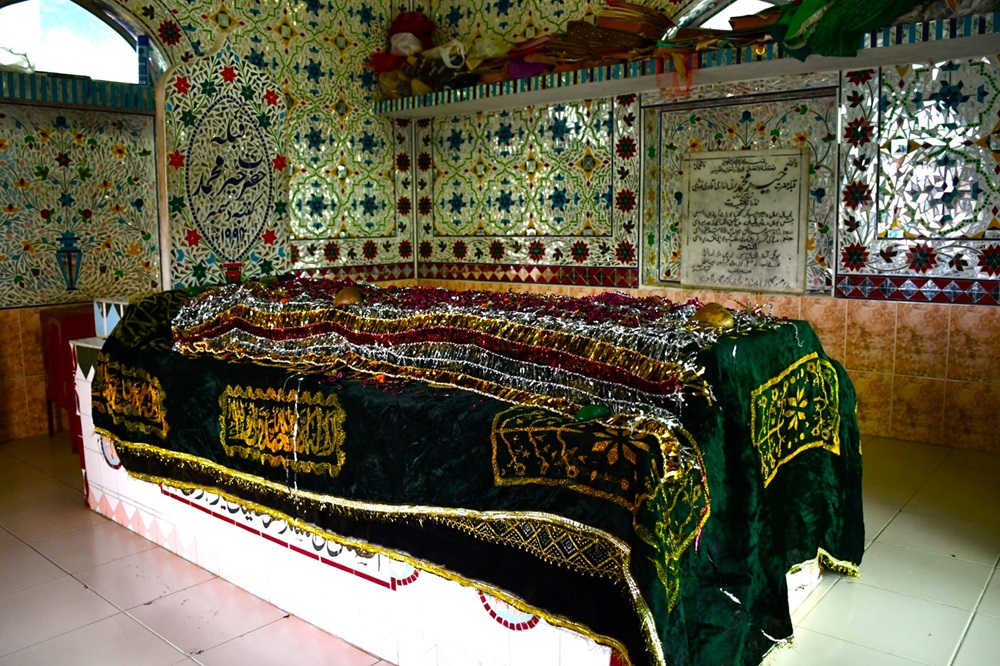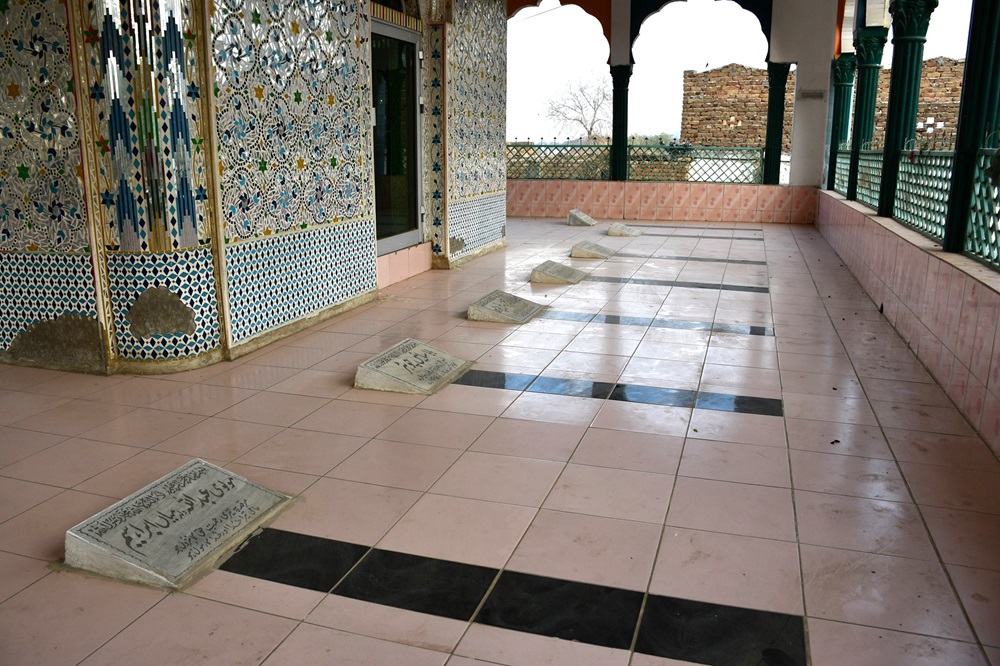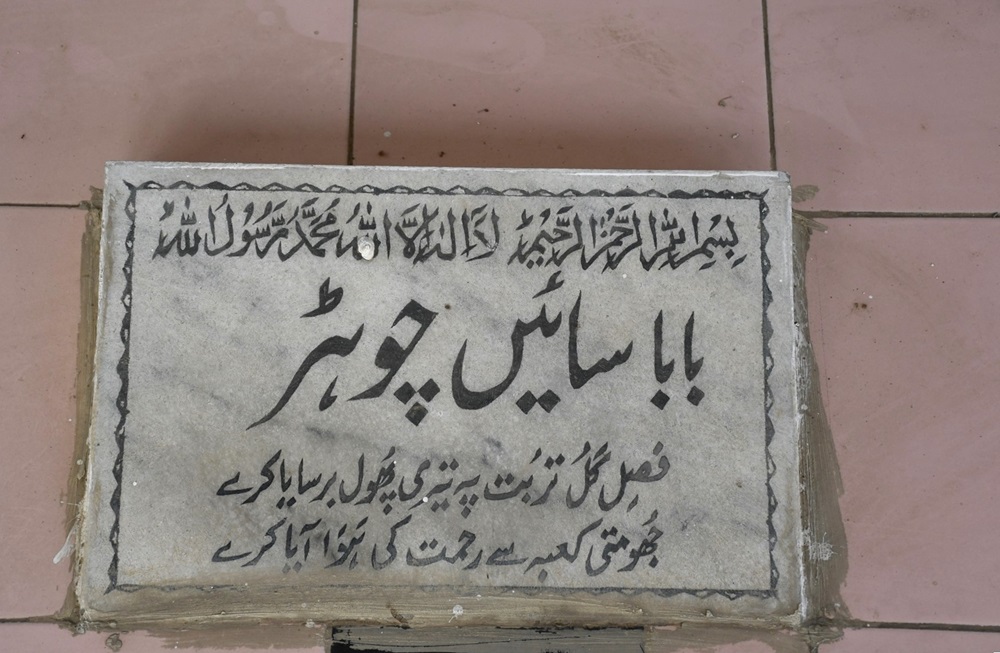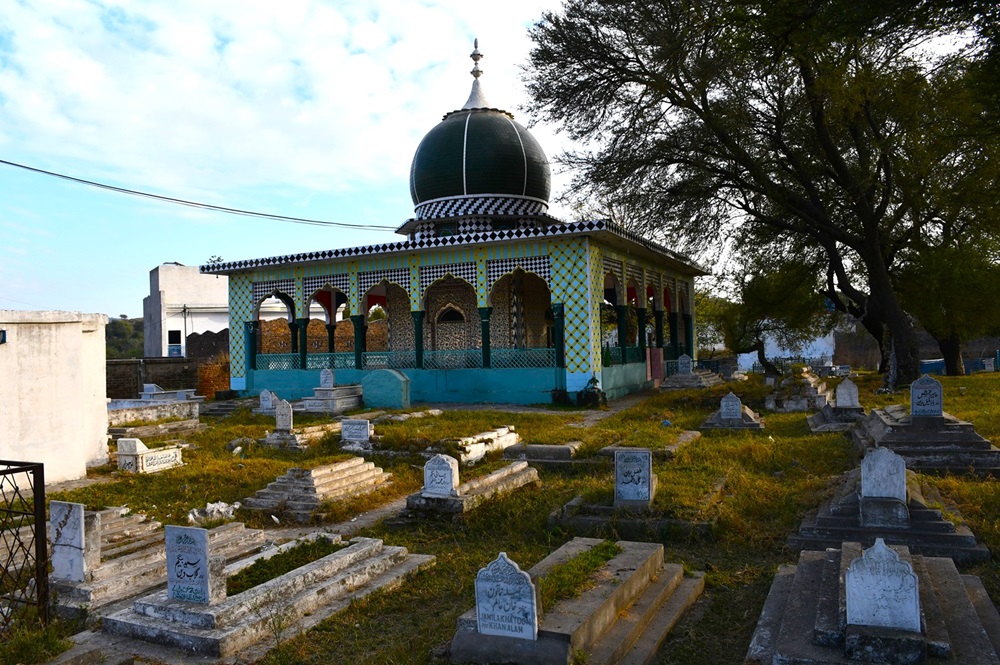
Written by: Zulfiqar Ali Kalhoro
Posted on: January 24, 2025 |  | 中文
| 中文
Shrine of Mian Khair Muhammad Qadiri Naushahi in Jabba village. (Picture credits to Zulfiqar Ali Kalhoro)
Islampura Jabbar, also called Jabbar Islampura, is a small town which is located in Rawalpindi’s Gujar Khan tehsil. There are many Sufi shrines in and around Islampura Jabbar. In this article, I will discuss two popular shrines located in this area. The oldest shrine is that of Mian Khair Muhammad Qadiri Naushahi, situated in Jabba village, close to Islampur town. Mian Khair Muhammad was a deputy of Syed Mir Kalan Badshah Qadiri Naushahi, whose shrine can be found in Rokhia Sharif in Gujar Khan tehsil.
According to Hasan Nawaz Shah (2013:26), the author of Gujar Khan ke Suhrawardi Mashaikh, four eminent deputies of Syed Mir Kalan Badshah were from Gujar Khan tehsil. They included Mian Muhammad Azeem Naushahi of Bhadana, Shaikh Muhammad Naushahi (d.1759) from Jand Najjar, Mian Muhammad Saeed Naushahi from Jairo Ratial, and Shaikh Khair Muhammad Naushahi (d. 1783-84) from Jabba village.

Grave of Mian Khair Muhammad Qadiri Naushahi in Jabba village. (Picture credits to Zulfiqar Ali Kalhoro)
Upon receiving a robe of initiation from Mir Kalan Badshah Qadiri Naushahi, Mian Khair Muhammad Qadiri Naushahi began preaching the Qadiriya-Naushahiyya silsila in Jabba and neighbouring villages. This location subsequently evolved into a prominent centre for the Qadiriya-Naushahiyya silsila. According to Muhammad Hanif Hanifi (1999:217), the author of Ruh Da Rishtia, Mian Khair Muhammad did not get married. He had a brother named Mian Aziz Bakhsh, whose descendants later managed and maintained the shrine of Mian Khair Muhammad Qadiri Naushahi shrine.
I have visited the shrine of Mian Khair Muhammad Qadiri Naushahi four times, first in 2015, later in 2019, 2020 and 2021. In the verandah of the tomb of Mian Khair Muhammad Qadiri Naushahi are the graves of his brother Mian Aziz Bakhsh’s family. On the southern side are rows of six graves. The first grave from the right belongs to Qazi Ghulam Mustafa (d.1978), son of Molvi Mian Abdullah, second to Bibi Jan (d.1964), daughter of Molvi Muhammad Ibrahim; third to Bibi Dori, the wife of Molvi Muhammad Ibrahim; fourth to Molvi Mian Muhammad Ibrahim, son of Baba Sain Chour, fifth to Baba Sain Chour and sixth to Molvi Mian Abdullah son of Molvi Mian Muhammad Ibrahim.

Graves in verandah of Mian Khair Muhammad Qadiri Naushahi. (Picture credits to Zulfiqar Ali Kalhoro)
To the eastern side are five graves; two are unidentified, while three others belong to Muhammad Akbar, son of Muhammad Alam; Mian Ghulam Murtaza, son of Molvi Mian Abdullah and Molvi Muhammad Azam, son of Molvi Mian Abdullah. Molvi Mian Abdullah was the son of Molvi Mian Muhammad Ibrahim, who was the son of Sain Baba Chour. Molvi Mian Abdullah had four sons: Mian Muhammad Azam, Mian Ghulam Qadir, Mian Ghulam Murtaza and Qazi Ghulam Mustafa. Three graves of Mian Abdullah’s sons are located in the eastern verandah of the tomb of Mian Khair Muhammad, while the grave of his fourth son, Mian Ghulam Qadir (d.1981), is located adjacent to the entranceway of the tomb of Mian Khair Muhammad Qadiri Naushahi. There are several other graves of Mian Aziz Bakhsh family members near the tomb of Mian Khair Muhammad Qadiri Naushahi. On the eastern wall of Mian Khair Muhammad Qadiri Naushahi's tomb, there is an inscribed slab that displays his name and the date of construction as 1994. This tomb was built through the dedicated efforts of Muhammad Hanif Hanfi, a renowned Punjabi poet and Sufi. He is recognized for his significant contributions to the construction of the tombs of various Naushahi saints in Gujar Khan and Kallar Syedan tehsils of Rawalpindi.

Grave of Baba Sain Chour in the verandah of Mian Khair Muhammad's tomb in Jabba. (Picture credits to Zulfiqar Ali Kalhoro)
The interior of Mian Khair Muhammad Qadiri Naushahi’s tomb is adorned with intricate glasswork. The tomb features a square design crowned with a dome and is enclosed by a spacious verandah. This architectural style is emblematic of several tombs in Punjab, which typically consist of square structures surrounded by expansive verandahs, reflecting the region's traditional design principles.
Many people became Mian Khair Muhammad Qadiri Naushahi's disciples and deputies. Sain Kala, whose shrine is situated in Burki Budhal in Gujar Khan, was one of his most distinguished deputies (khalifa). He played an important role in spreading the teachings of his spiritual mentor. One of the prominent deputies of Sain Kala was Khalifa Fatehuddin Majzub Barqandazi. Muhammad Hanif Hanfi (1999) states in Ruh Da Rishta that he was popularly known as Sain Fatu. Khalifa Fatehuddin Majzub Barqandazi, also called Pir Fateh Ali alias Khalifa Sahib by the local community, was associated with the profession of shoemaking (Kafshdozi) in Pind Bainso village in Rawalpindi’s Kallar Syedan tehsil. He frequently visited his spiritual master, Sain Kala (d.1863), at Barki Budhal village in Gujar Khan. Khalifa Fatehuddin Majzub Barqandazi also had many disciples. One of his eminent disciples was Sain Barkhurdar, whose shrine is located in Nala Musalmana’s Mohra Kunwan village, 2 km east of Pind Bainso village. It is said that Sain Barkhurdar used to grind wheat at Chakki of Khalifa Fatehuddin Majzub Barqandazi and became his disciple. Sain Barkhurdar was also known for his piety in his village. While, Sain Barkhurdar’s son, Sain Eddu, was also an eminent mystic of the village. A tomb has been built over the graves of both father and son at Mohra Kunwan in Nala Musalmana village in Kallar Syedan tehsil.

The shrine of Mian Khair Muhammad Qadiri Naushahi in Jabba village. (Picture credits to Zulfiqar Ali Kalhoro)
Mian Khair Muhammad Qadiri Naushahi's followers actively promoted the Qadiriyya-Naushahiyya order in the Gujar Khan and Kallar tehsil regions. Aside from the shrine of Mian Khair Muhammad Qadiri Naushahi, the shrine of Syed Atta Hussain Shah, also known as Sain Mirchu Qalandar, is the most popular in Islampura town. Muhammad Muneer Chishti (2002) states in “Hayat-e-Qalandar" that Sain Mirchu Qalandar hailed from the small village of Chauhan Syedan in Chakwal. He travelled to Baramulla in Jammu and Kashmir for meditation. Eventually, he went through Dangali to Jabbar in Gujar Khan, where he settled and passed away in 1946. An imposing tomb was built over his grave. It is one of the most impressive tombs in Gujar Khan tehsil. It is noted for its bulbous dome and spacious verandah. The genealogy of Syed Atta Hussain Shah is written on the canopy over his grave. The graves of his family members are found adjacent to the tomb.
The shrine of Sain Mirchu Qalandar attracts devotees and visitors daily. During the annual festival, or mela, which takes place on March 5th, 6th and 7th, the shrine becomes filled with pilgrims who travel from far and wide to participate in the event.
The writer is an anthropologist. He has authored 17 books on Pakistan's cultural heritage and anthropology. He tweets @kalhorozulfiqar. He may be contacted at zulfi04@hotmail.com
You may also like: